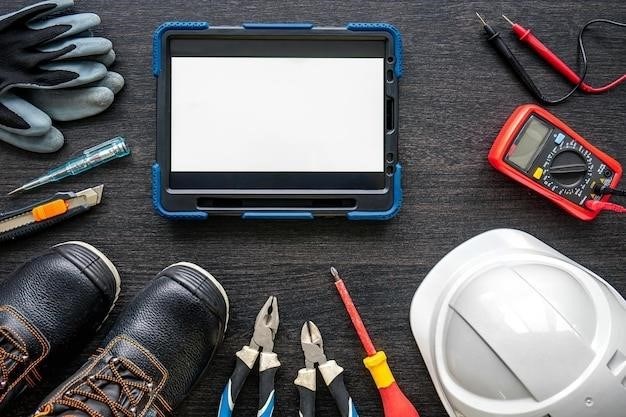Manual vs. Auto Ranging Multimeters⁚ A Comparison
Auto-ranging multimeters automatically select the appropriate measurement range, simplifying operation, especially for beginners. Manual-ranging multimeters require manual range selection, offering more control and potentially faster readings for experienced users. Both types offer advantages depending on user skill and application.
Introduction⁚ Key Differences
The primary distinction between manual and auto-ranging multimeters lies in how they determine the appropriate measurement range. Auto-ranging multimeters automatically adjust the range based on the input signal, providing a user-friendly experience, especially beneficial for beginners or those performing quick measurements. This eliminates the need for manual range selection, simplifying the measurement process; Conversely, manual-ranging multimeters require the user to select the appropriate range before taking a measurement. This necessitates some prior knowledge of the expected measurement value to prevent damage to the meter or inaccurate readings. While potentially more time-consuming, manual ranging offers greater control and can lead to faster readings once the appropriate range is selected, particularly when performing repetitive measurements within a known range. The choice between these two types hinges on individual needs and experience levels.
Auto-Ranging Multimeters⁚ Ease of Use and Simplicity
Auto-ranging multimeters are designed with user-friendliness in mind. Their automatic range selection feature eliminates the need for manual adjustments, making them ideal for beginners or those prioritizing speed and convenience. Simply connect the probes, and the meter automatically determines the appropriate range for accurate measurement. This streamlined process minimizes the risk of user error, such as selecting an inappropriate range that could damage the meter or lead to inaccurate readings. The ease of use translates to faster testing and reduces the learning curve associated with using multimeters. This characteristic makes auto-ranging multimeters a popular choice for various applications, from basic household electrical checks to educational purposes where ease of use is paramount. The simplicity of operation allows users to focus on the task at hand rather than on the intricacies of manual range selection. However, it’s important to note that this automatic functionality might slightly increase measurement time in some cases compared to manual ranging.
Manual Ranging Multimeters⁚ Precision and Control
Manual ranging multimeters offer a level of precision and control often preferred by experienced users. By manually selecting the measurement range, users gain a deeper understanding of the expected values and can optimize the meter’s performance for specific tasks. This control minimizes the potential for the meter to automatically select an unsuitable range, which can sometimes occur with auto-ranging models, leading to longer measurement times or less precise readings. The manual selection process allows for faster readings when measuring repetitive values, as the user doesn’t need to wait for the auto-ranging function to settle on a range. Furthermore, the direct control offered by manual ranging can be advantageous when working with sensitive components or in situations where the precise range is already known. This hands-on approach is often appreciated by professionals who value speed and accuracy in their measurements. While requiring more user expertise, manual ranging offers a degree of fine-tuning unavailable in auto-ranging models. The added control ensures that the user can confidently choose the most appropriate range for each specific measurement, leading to potentially more accurate and reliable results.

Advantages and Disadvantages
Both auto-ranging and manual-ranging multimeters present distinct advantages and disadvantages. The optimal choice depends heavily on the user’s experience level and the specific application requirements of the task at hand.
Auto-Ranging⁚ Pros and Cons
Auto-ranging multimeters offer undeniable convenience, especially for novice users. The automated range selection eliminates the guesswork involved in manual ranging, reducing the risk of accidental damage from incorrect range settings. This ease of use makes them ideal for quick measurements and less demanding applications. However, the automatic range selection process can introduce a slight delay in obtaining readings compared to manual ranging. This delay can become significant when performing numerous consecutive measurements. Additionally, the automatic selection might not always choose the optimal range for the highest accuracy in certain scenarios, potentially sacrificing precision for convenience. While generally reliable, the auto-ranging feature could occasionally lead to slightly less precise readings than a carefully chosen manual range. Furthermore, the constant searching for the optimal range might slightly reduce the lifespan of some components within the multimeter.
Manual Ranging⁚ Pros and Cons
Manual ranging multimeters provide users with greater control and potentially faster readings once the correct range is selected. Experienced users can quickly select the appropriate range, minimizing any delay in obtaining measurements. This direct control often leads to quicker readings compared to auto-ranging, particularly when performing repetitive measurements on components with known value ranges. Manual selection allows for optimization of the measurement range for maximum precision, ensuring the most accurate readings possible. However, manual ranging requires a greater understanding of electrical measurements and potential risks associated with selecting incorrect ranges. Improper range selection can lead to inaccurate readings or even damage to the multimeter. The learning curve for manual ranging can be steeper for beginners, and choosing the wrong range may lead to instrument damage. Furthermore, the need to manually select each range adds an extra step to the measurement process, potentially slowing down workflows for those unfamiliar with the device.
Choosing the Right Multimeter
Selecting a multimeter depends on user expertise and intended application. Consider factors such as auto-ranging versus manual-ranging capabilities, safety ratings (CAT III and CAT IV), and the need for advanced measurement functions.
Factors to Consider⁚ User Expertise and Application
The choice between an auto-ranging and manual-ranging multimeter significantly hinges on the user’s experience and the specific application. Beginners often find auto-ranging multimeters more user-friendly due to their simplified operation; the instrument automatically selects the appropriate measurement range, eliminating the need for manual adjustments and reducing the risk of errors. This ease of use makes them ideal for basic tasks and introductory electrical work. However, experienced technicians might prefer manual-ranging multimeters for their enhanced precision and speed. The ability to manually select the range allows for quicker readings in repetitive measurements, a crucial advantage in professional settings where efficiency is paramount. Moreover, manual ranging offers greater control, allowing for more precise measurements when dealing with potentially delicate components. The application itself also dictates the optimal choice. Simple household tasks or educational purposes may not necessitate the speed and precision of manual ranging; auto-ranging’s convenience proves more suitable. For professional use, particularly in situations demanding rapid measurements and fine-tuned control, manual ranging’s capabilities are invaluable. Ultimately, the ideal multimeter aligns perfectly with the user’s skill level and the demands of the specific application.
Safety Ratings⁚ CAT III and CAT IV
When selecting a multimeter, especially for professional applications or high-voltage work, understanding safety ratings like CAT III and CAT IV is crucial. These ratings, established by IEC 61010-1, indicate the multimeter’s ability to withstand transient voltage surges and overvoltages typical in specific environments. CAT III ratings are suited for measurements in typical building installations, such as household wiring and industrial control systems, where the risk of voltage spikes is moderate. CAT IV ratings offer higher protection and are necessary when working with high-voltage sources, such as overhead lines and utility power systems, where the potential for severe voltage transients is significantly greater. Choosing a multimeter with an appropriate CAT rating is essential for user safety. Using a lower-rated multimeter in a higher-voltage environment can lead to equipment damage and even serious injury. Before selecting a multimeter, carefully assess the voltage levels and potential risks involved in your planned use. The CAT rating should always match or exceed the expected voltage and transient conditions to ensure safe and reliable operation. Prioritizing safety by selecting a properly rated multimeter is paramount for any electrical work.

Features and Capabilities
Multimeters offer various features beyond basic measurements, including capacitance testing, frequency measurement, temperature sensing, and diode testing. The choice depends on individual needs and project complexity.
Beyond Basic Measurements⁚ Advanced Functions
Modern multimeters frequently extend beyond fundamental voltage, current, and resistance measurements, incorporating sophisticated functionalities valuable for specialized tasks and experienced users. These advanced capabilities significantly enhance the multimeter’s versatility and diagnostic power. Capacitance testing allows the measurement of a capacitor’s ability to store electrical charge, crucial for assessing component health in electronic circuits. Frequency measurement capabilities determine the rate of cyclical electrical variations, essential for analyzing AC signals and identifying potential issues in power supplies or signal processing systems. Temperature sensing probes enable the assessment of temperature-related parameters, broadening applications to thermal analysis and troubleshooting within electrical and electronic systems.
Diode testing provides a quick assessment of diode functionality, confirming forward and reverse bias characteristics. True RMS (Root Mean Square) measurements provide accurate readings for AC waveforms, crucial for power systems analysis. Data logging capabilities record multiple measurements over time, useful for monitoring trends or analyzing dynamic electrical behaviors. Min/Max recording functions identify peak and minimum values during measurements, beneficial when observing fluctuating signals. High current measurement capabilities allow the multimeter to safely handle high-amperage currents present in industrial or high-power systems.
Digital vs. Analog Multimeters
Digital multimeters (DMMs) display measurements numerically on an LCD screen, offering clear, easy-to-read results. They often feature auto-ranging, simplifying operation and enhancing speed. DMMs typically provide higher accuracy and faster response times compared to analog counterparts. However, some DMMs may introduce a small current during testing, potentially damaging sensitive electronic components. Analog multimeters use a moving needle on a calibrated scale to indicate measurements. These offer a visual representation of voltage fluctuations, which can be beneficial in certain applications. Analog meters are generally more rugged and less susceptible to damage from electrical surges. They are often preferred for applications requiring high sensitivity or minimal current draw to avoid affecting delicate circuits.
The choice between digital and analog depends on the specific needs of the user and the application. Digital multimeters are widely popular due to their ease of use and accuracy, making them suitable for a broad range of applications; Analog multimeters maintain a niche in situations requiring high sensitivity and where slight current draw is crucial. Both types serve valuable purposes, but their strengths and limitations must be carefully considered before selecting a multimeter for any specific task.
